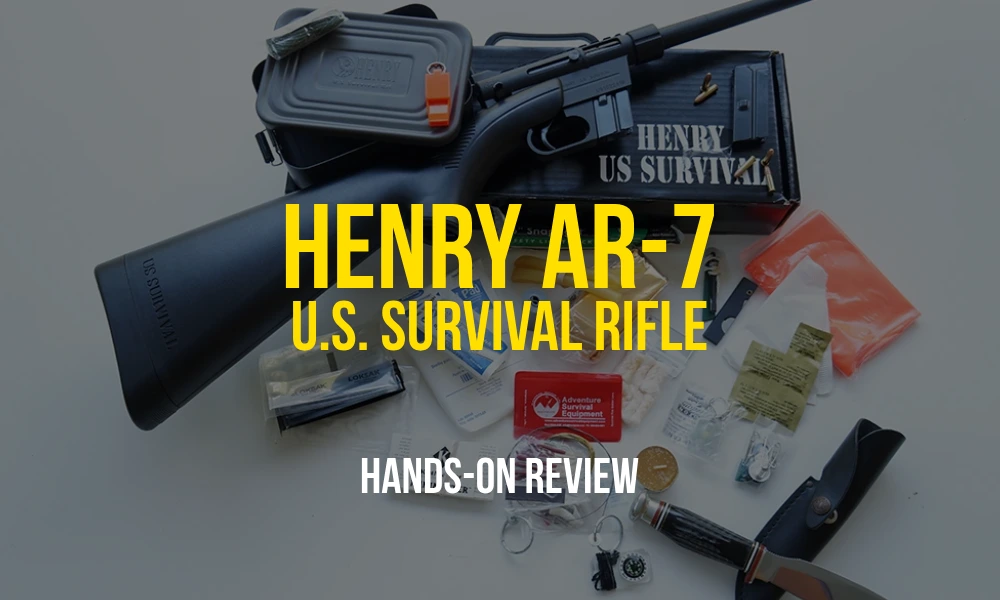
Last Updated on
In this article, I’m going to take a thorough look at the Henry AR-7 Survival .22 Rifle.
In the face of economic down fall and turmoil in the news worldwide over the past decade, there has been a growing interest in post-apocalyptic survival by people of all walks of life. It’s no coincidence television reality shows like Survivorman, Mountain Men, Survivor and anything associated with Bear Grylls are popular with weekly viewers. Topics such as bushcrafting, camping, and hunting are no longer being studied by just outdoor enthusiasts. Bankers, lawyers, doctors and company CEO’s are now putting down their cell phones and laptops to pick up a backpack and ax to learn to survive if and when the power grid goes down.
When we look at what is needed to survive in an emergency situation, we often look to our military for equipment and training ideas. While civilians are usually mesmerized by the high speed tactical gear, there is one tool depended upon by the U.S. Air Force pilots since 1959 that is often overlooked – the Eugene Stoner designed semi-auto AR-7 .22 caliber survival rifle. While most of us are not military pilots and are not able to access this particular item, an improved civilian version of the rifle has been quietly produced for some time now.
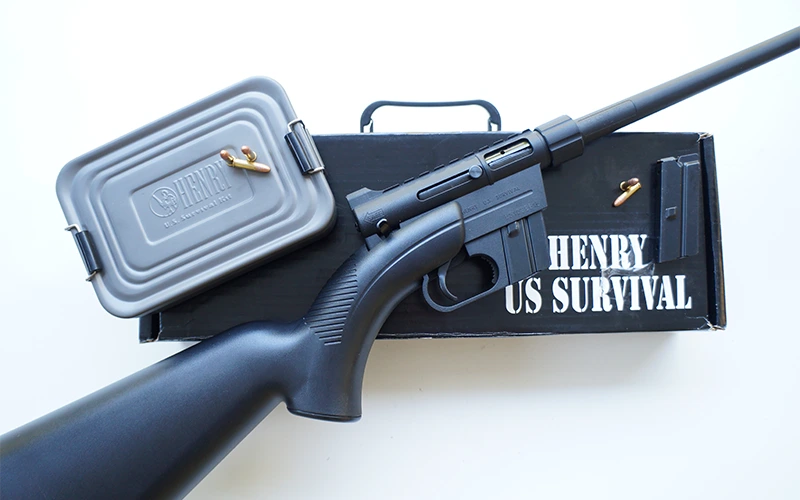
The aptly-named Henry U.S. Survival Rifle is available in black, True Timber-Kanati and Viper Western Camo. This rifle is often listed also as the Henry AR-7. Often overshadowed by Henry’s very popular lever action series of rifles, this little semi-auto .22LR rifle provides the perfect tool for civilian bush pilots, backpackers and preppers around the world looking for a small caliber compact rifle for emergency situations. When disassembled, the Henry rifle fits easily in a boat hatch, overhead storage bin or a side pouch of a “Bug-out Bag.”
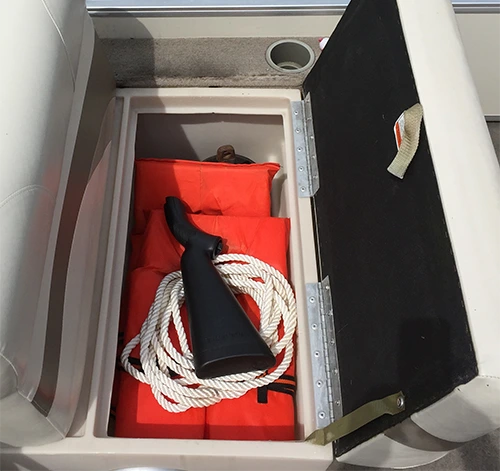
Breaking Down the Henry AR7 Survival Rifle
Early last year, I received a sample of the Henry Survival Rifle from nice folks at Henry Repeating Arms for review. As a long-time fan of Henry rifles, I was well versed in their version of the AR-7 rifle already, but this would be the first chance to get some quality time with one in person. When the rifle arrived at my local gun shop, I was surprised at how small the box was. Upon opening the plain black box marked Henry U.S. Survival Rifle, it appeared as if they had only shipped a 16” long plastic stock. I took the gun out of the box and popped the butt pad off the rear of the stock to reveal the rest of the rifle securely nestled away inside. At a total weight of only 3.5lbs, I was very impressed how lightweight the total package was.
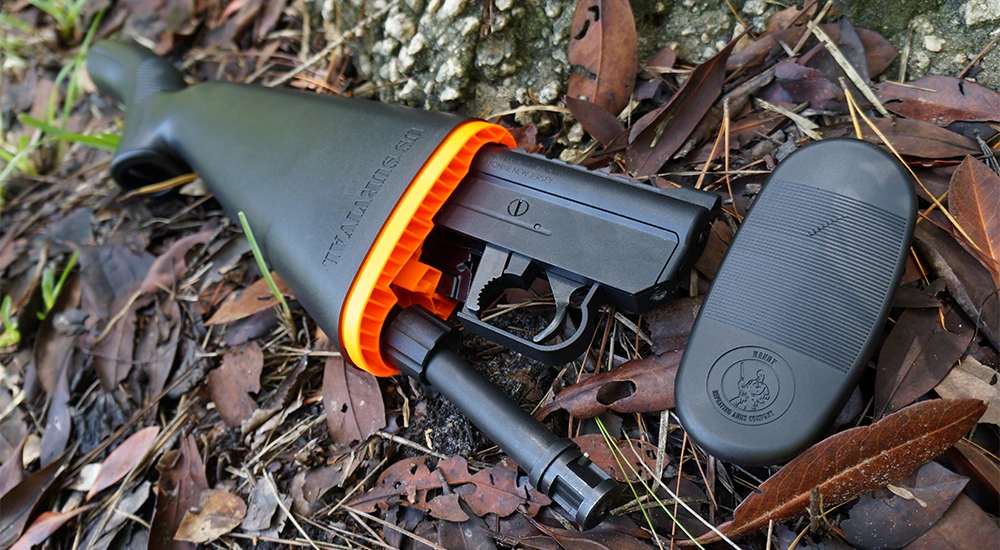
I removed the barrel with attached nut, two magazines and receiver from the rear of the stock and secured the butt pad back on the gun. I started assembly by placing the rear of the receiver into the forked groove in the front of the stock and secured it in place by means of a turn screw underneath the pistol grip until it was tightly fitted. Next, I dropped the barrel onto the front of the receiver into a notch cut out for a barrel pin similar to an AR-15 and used the attached barrel nut to hand tighten the barrel down. A simple click of one of the 8 round .22 caliber magazines into the cut out magazine well and the whole rifle was assembled in all of about 45 seconds!
Fully assembled, the Henry Survival Rifle was only 35 inches long, making it perfect to maneuver through thick bush or over harsh terrain. The receiver and barrel were Teflon coated to protect against corrosion from inclement weather and even salt water. The receiver is grooved to mount a small air gun size scope, but for what the rifle is built to be, its supplied iron sights are more than adept for the task. The rear sight is an adjustable peep hole which lines up quickly with the highly visible orange fixed bladed front sight. As I discovered quickly, the charging handle had to be popped out from the side to load the first round into battery and after that, the rest was easy. Once I familiarized myself with the operation of the rifle, I was ready for some quality time outdoors with the Henry.
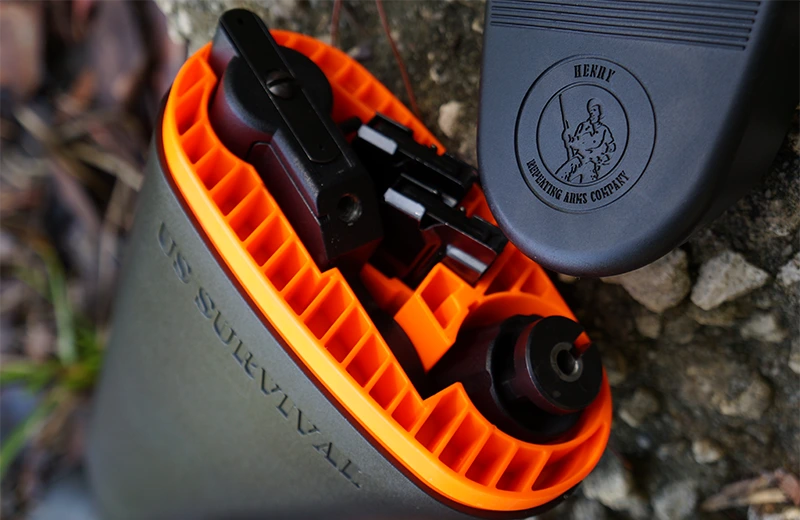
Field Time with the Henry AR7 Survival Rifle
Since the Henry AR7 was considered more of a survival tool that it was a range rifle, I decided to reach out to my close friend and resident Swanson Media Group bushcraft expert, Craig Reinolds for his thoughts while testing this rifle earlier this summer when it first arrived. I loaded up the Henry magazines 40 grain CCI Mini Mag Hollow Point ammunition and test fired the rifle at a small game distance of 15 and 25 yards and fired at small polymer and steel targets roughly 4 – 5 inches tall. These rounds push close to 1235 ft/s and have proven in other .22 rifles to be the best all-round performers in non-suppressed platforms.
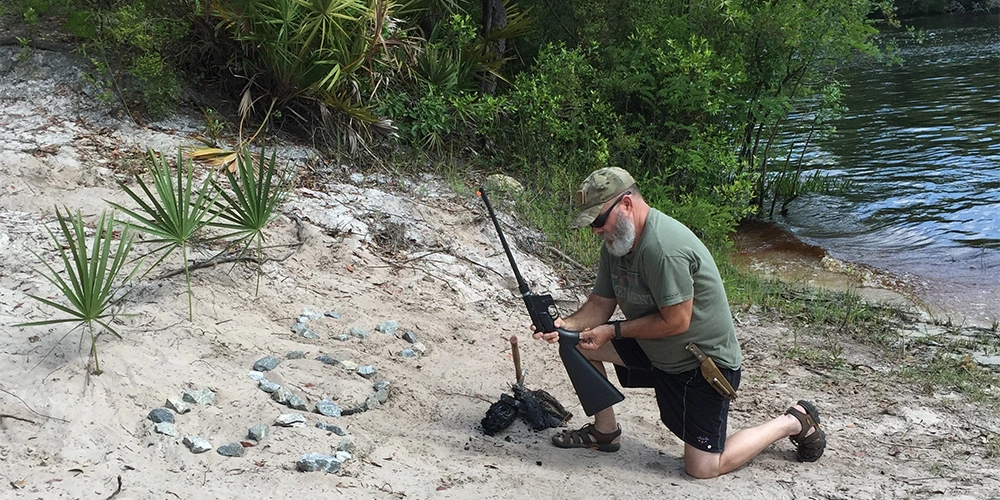
While awkward at first, I shouldered the Henry AR7 rifle and quickly got use to the offset configuration of how the barrel sits on the stock to accommodate the storage area inside. The trigger felt a bit stiff but broke cleanly considering it is a survival tool meant to be there in an emergency while my match grade precision rifle is at home collecting dust in the safe. Both Craig and I took turns running through box after box of the diminutive CCI ammo with only one operator induced failure. Due to the lack of a handguard, the shooter must choke up on the receiver with the support hand to prevent getting burned by a hot barrel over a prolonged period of shooting. With the deep cut out in the receiver for the magazine to fit flush, it’s easy to accidentally grab the exposed outside edge of the magazine and apply enough pressure to cause a misfeed. Once I caught myself doing this, I corrected my grip and continued shooting with no further issue. Learning from my mistake, Craig ran the rifle with no issue, shot after shot, rocking our “minute of squirrel” size targets back and forth. The bright orange front sight was easy to line up against the black background of the targets and transitioned quickly from each one with very little felt recoil.
Due to the takedown configuration, the Henrey Survival Rifle is extremely easy to clean up after shooting by using a simple Hoppe’s Bore Snake and an old tooth brush. After oiling the the rifle down and stowing the parts back inside the stock, I decided to see how it would do if dropped accidentally in a river or lake. Once I arrived back home from the range, I took the rifle into the back yard and simply tossed the unassembled rifle into the pool. After the splash, the Henry AR7 rose to the top of the water and began to float around in the water’s current. After a few minutes, I noticed the rear of the stock started to slowly sink under the water line. Within less than 5 or 6 minutes, the rifle then sank to the bottom of the pool. I fished the Henry out of the water and opened the back cover of the stock. Water poured out of the stock as if I had used it for a canteen. I rinsed the salt water off all the parts with fresh water and wiped everything down with a towel before re-oiling. For rain or sea spray, the stock would work excellent for protecting the parts inside, but failed the long term submersion test. If I were to keep this on a boat, I would at least tether the rifle to some sort of flotation device in case of capsizing.

As things often do in the summer, projects overlapped, and the Henry AR-7 Survival Rifle spent the summer riding around on the boat as well as the back of my Chevy Suburban inside my “bug out” bag without being shot much. I decided to do a bit more field testing with my good friend and newest member of the Swanson Media Group, Clint Steele. Like Craig, Clint is not only a SMG staff writer, but military veteran as well. Having served with both the U.S. Marine Corps and retiring from the U.S. ARMY, Clint has spent a lifetime studying the key tools to survival. As a long time fan of the concept and design of the US Survival rifle, this would be his first time getting an opportunity shooting one.
Using the same CCI Mini Mag Hollow Points as earlier in the year, Clint and I set out to work on some swinging steel targets 50 yards down range and try to capture some of the fun on video as seen in the attached video segment. Using the small rear peep sights and blaze orange front sight, the sight alignment and picture were quick to be gained on target. Again, the trigger felt stiff but more manageable than before due to more rounds having been put through the rifle as well as having previously gotten plenty of time in on using the trigger and adapting to it.
Clint’s first shots were dead on as he slowly broke the trigger. First impressions on the overall compact design and accuracy was that it excels in what it’s designed to be. True, it’s no target rifle, but as I have previously mentioned, it’s a great asset to have when you’re prized rifle is sitting at home. As the day wore on, Clint and I had some great discussions on how to best carry and deploy the AR-7. By the end of the day, if there were a dozen Henry U.S. Survival Rifles available, we would have bought them all to store in our vehicles, boats, and “go” bags. At only 3.5 lbs and 16.5” inches when disassembled, the AR-7 definitely can fit easily anywhere you wish to store it for a “rainy day.”
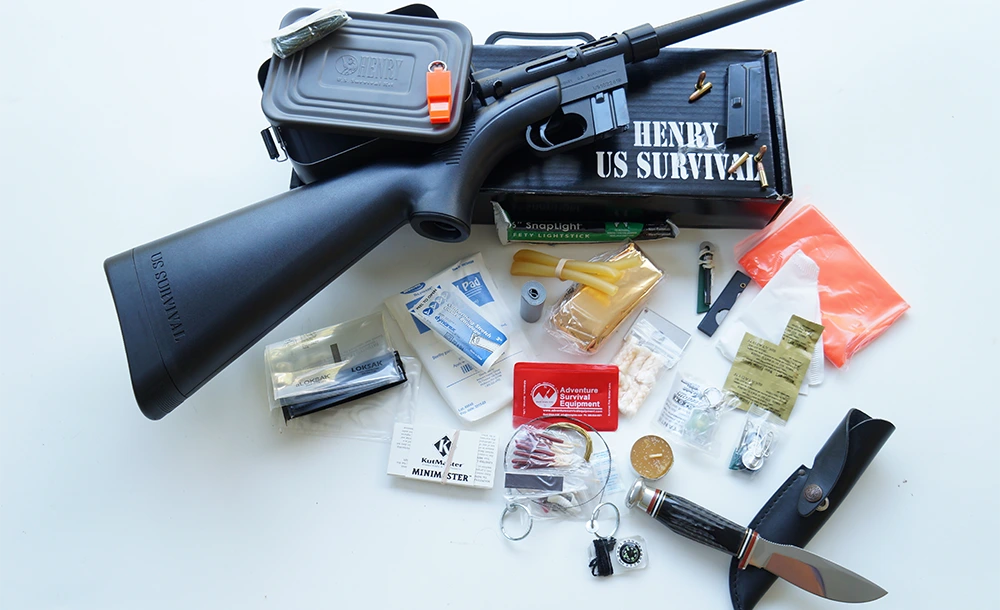
Final Thoughts
Over the past year, the Henry U.S. Survival Rifle has ridden up and down the St. James River stowed the in hull of a pontoon boat, rode across fields on horseback and lugged around in a Bug-Out Bag, but I’ve always had confidence in its capabilities if its ever needed in a life or death situation. Unlike other survival rifles I have reviewed in the past, I like the fact the Henry is a singular compact unit that does not have extra parts to worry about. I feel the U.S. Survival Rifle is well built and durable for long term storage or use. I would like to see some sort redesign to allow for a small handguard for those who just enjoy a day of plinking with the little rifle.
In addition to the rifle, Henry included a neat little tin box loaded with additional survival tools such as a signal mirror and whistle, wire saw, waterproof matches, rubber tubing, emergency blanket and snap light. Made for Henry Repeating Arms by Best Glide ASE, the box is water tight and can be used for a wide array of task such as constructing shelter, snares and starting fires in the field. While this is not included in the sale of the rifle, it is an excellent item to consider pairing with the Henry Survival Rifle.
Retailing at $290, I have seen these rifles in stores listed on sale for a bit cheaper at around $230. The quality and reliably you get with this and any other Henry product is second to none for the money you invest. After spending time with the Henry, it proved itself to the point of wanting to refer to it as a tool more than a firearm. Everything about its design and function are made to help you be confident in overcoming life threatening situations and survival! Until next week, Train Hard and Continue the Fight!




Leave a Reply